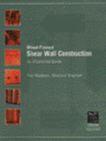Business Articles - On the Job
Articles & Tips
by Tim Uhler
As a framer, I have found it difficult to keep up with all the changes that happen in the building code. One of the more confusing areas of the code has to do with the proper construction of shear walls. I can't tell you how many fellow carpenters I've talked to who think building a shear wall is simply a matter of adding more nails to the sheathing.
It's hard to find information about shear walls that is concise and easy to understand. The only place I know to get it is in Thor Matteson's book, Wood-Framed
Shear Wall Construction — An Illustrated Guide.
 Wood-Framed
Shear Wall Construction An Illustrated
Guide, by Thor Matteson, Structural Engineer (International
Code Council, Inc., 2004), 800/786-4452. Wood-Framed
Shear Wall Construction An Illustrated
Guide, by Thor Matteson, Structural Engineer (International
Code Council, Inc., 2004), 800/786-4452. |
Importance of Shear Walls
Shear walls are an extremely important part of the frame. Building them properly
is every bit as important as correctly sizing the structural members. The book
clears up common misconceptions, such as the belief held by many older carpenters
that since shear walls didn't used to be required, why make such a big deal
out of them now? Matteson's book has about as many pages as the magazine
you're reading right now. It's filled with pictures and tables to illustrate
the points the author is trying to make.
In my experience the biggest impediment to the proper construction of shear
walls is the lack of understanding on the part of the carpenters, superintendents,
and foremen who are in charge of building them. Matteson's book provides the
necessary background so that those of us in the field can understand how shear
walls work and the role they play in the performance and longevity of a wood-framed
home. The pictures and diagrams make it much easier to understand the principles
involved.
Common Errors
A chapter on basic construction requirements covers common field errors and
points out differences between what the code might say and what materials are
actually available in the field. I especially like the photos that show what
to do and what not to do when you're building a shear wall. They look like
they could be from my job or the job down the road. For example, there's a
picture of a J-bolt that was not set high enough so, of course, the carpenters
notched the sill plate around it. We've all seen this kind of thing, and Matteson
makes it clear why it's not acceptable in a shear wall.
Another chapter covers the manufactured shear walls that have become so common
in recent years. It also introduces the reader to collectors; how they work
and mistakes to avoid when building them. The last part of the book discusses
advanced topics such as how to deal with shear walls that have windows in them
and what do when the top of the wall is sloped (rake walls) or when the building
has stepped footings.
The author's past experience as a carpenter proves invaluable because he understands
that it's one thing to design something on a piece of paper and another to
actually build it on site. One of my pet peeves is that I sometimes have to
deal with engineers and inspectors who have no real-world experience with building
things. It's as if carpenters, inspectors, and engineers are all speaking different
languages. The best thing about Matteson's book is that it's written in language
that can be understood by anyone.
I have read this book a couple of times and keep a copy in my truck. In my
opinion, it should be required reading for superintendents, inspectors, and
anyone who leads a framing crew.
Tim Uhler is lead framer for Pioneer Builders Inc. in Port Orchard, Wash.
This article has been provided by www.jlconline.com. JLC-Online is produced by the editors and publishers of The Journal of Light Construction, a monthly magazine serving residential and light-commercial builders, remodelers, designers, and other trade professionals.
Join our Network
Connect with customers looking to do your most profitable projects in the areas you like to work.

